Catalog
Topic 1: Minimum distance of characters
Question 3: Determining whether each other is character rearrangement
Topic 4: Perimeter of an island
Topic 5: The intersection of two arrays
Title 6: Calculating prime numbers
Question 8: The average number of layers of a binary tree
Topic 9: Building a Binary Search Tree
Question 10: Candy distribution
LeetCode regularly brushes the questions, with 10 questions in each issue. Business-heavy comrades can see the ideas I share. They are not the most efficient solution, they only want to improve each other.
Topic 1: Minimum distance of characters
The test requirements are as follows:
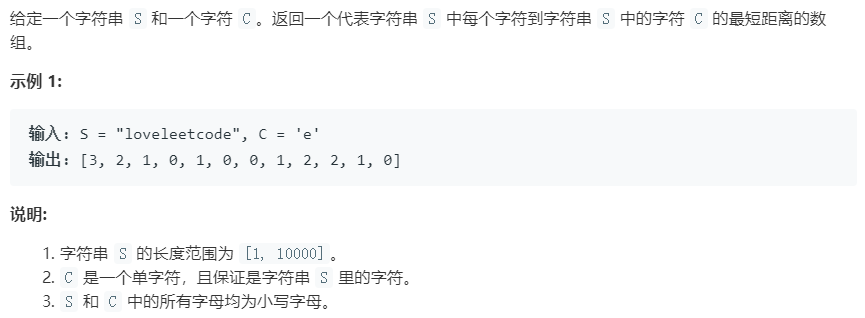
Solution ideas:
Traversing left to right, recording the position prev where the last character C appeared, the answer is i - prev.
If you want to traverse from the right and record the position prev where the last character C appeared, the answer is prev - i.
The minimum of these two values is the answer.
Answer (C language):
/** * Note: The returned array must be malloced, assume caller calls free(). */ int* shortestToChar(char * S, char C, int* returnSize){ int tmp1,tmp2; int len = strlen(S); int* ret = (int *)malloc(len * sizeof(int)); for(int i = 0; i < len; i++) { tmp1 = 0; for(int j = i; j >= 0; j--) { if (S[j] != C) { if (j == 0) { tmp1 = len; } else { tmp1++; } } else { break; } } tmp2 = 0; for(int j = i; j < len; j++) { if (S[j] != C) { if (j == len-1) { tmp2 = len; } else { tmp2++; } } else { break; } } ret[i] = tmp1 < tmp2 ? tmp1 : tmp2; } *returnSize = len; return ret; }
The operating efficiency is as follows:

Question 2: Baseball Match
The test requirements are as follows:
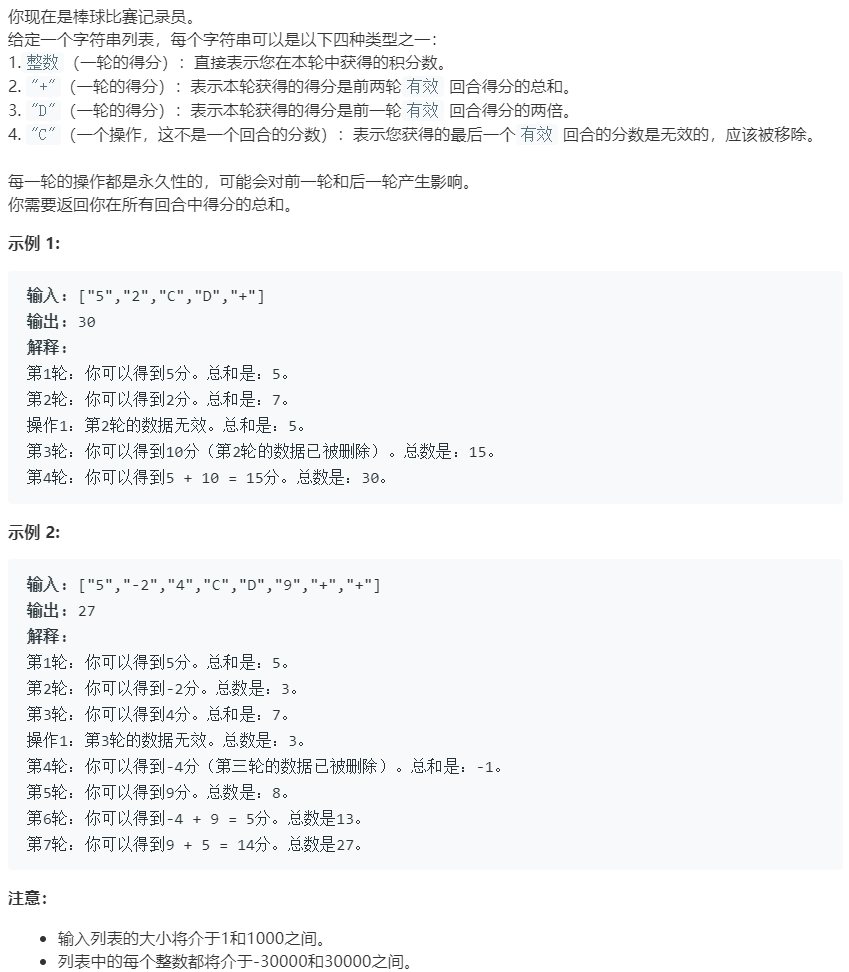
Solution ideas:
Stack ideas.
Answer (C language):
int calPoints(char ** ops, int opsSize){ int arr[1000]={0}; int score = 0,i = 0,j = 0; while(i < opsSize){ switch(ops[i][0]){ case 'C': arr[j-1]=0; j-=2; break; case 'D': arr[j]=arr[j-1]*2; break; case '+': arr[j]=arr[j-1]+arr[j-2]; break; default: //String type to integer type arr[j]=atoi(ops[i]); break; } j++; i++; } for(int i=0;i<j;i++){ score+=arr[i]; } return score; }
The operating efficiency is as follows:

Question 3: Determining whether each other is character rearrangement
The test requirements are as follows:
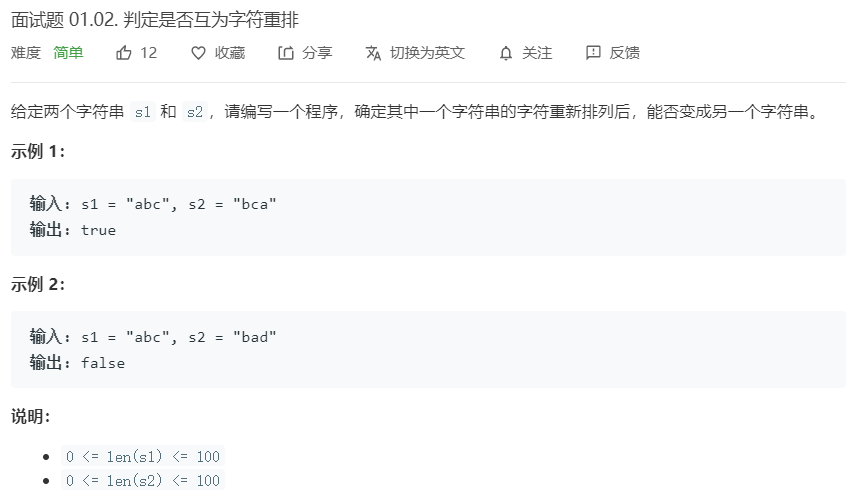
Answer (C language):
bool CheckPermutation(char* s1, char* s2){ int i = 0,j = 0,s1Len = 0,s2Len = 0; s1Len=strlen(s1); s2Len=strlen(s2); if(s1Len != s2Len){ return false; } char letter[26]={0}; for(i=0;i<s1Len;i++){ letter[s1[i]-'a']++; } for(i=0;i<s2Len;i++){ letter[s2[i]-'a']--; } for(i=0;i<26;i++){ if(letter[i]!=0){ return false; } } return true; }
The operating efficiency is as follows:

Topic 4: Perimeter of an island
The test requirements are as follows:
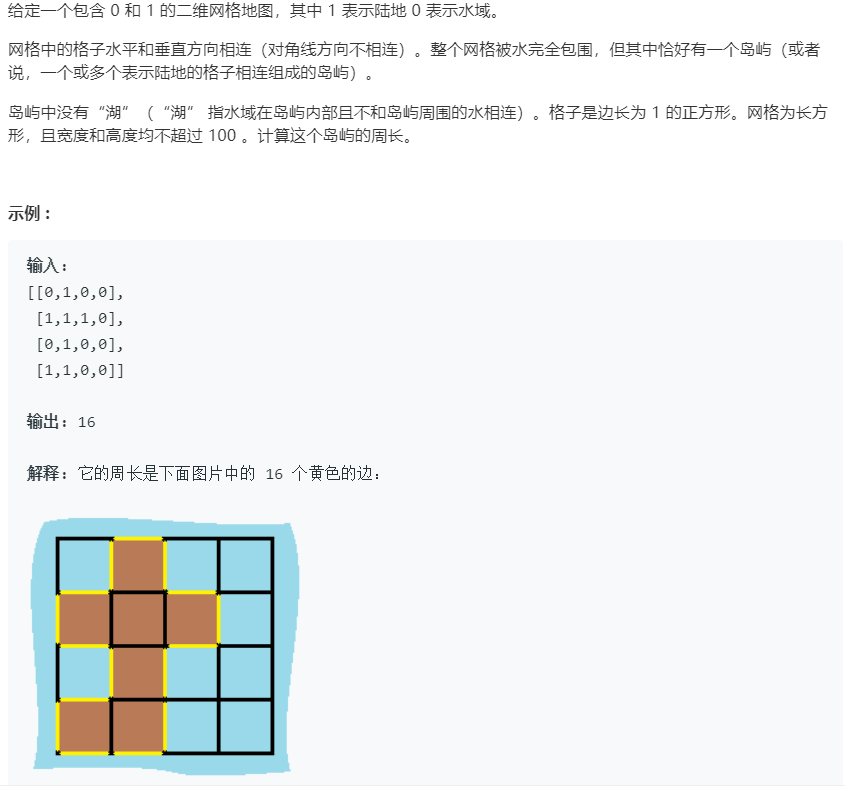
Solution ideas:
Each island with four directions around +4 is -1.
Answer (C language):
int islandPerimeter(int** grid, int gridSize, int* gridColSize){ int circle = 0; for (int i = 0; i < gridSize; i++) { for (int j = 0; j < (*gridColSize); j++) { if (grid[i][j] == 1) { circle +=4; if (i > 0 && grid[i-1][j] == 1) { circle--; } if ((i + 1) < gridSize && grid[i + 1][j] == 1){ circle--; } if (j > 0 && grid[i][j - 1] == 1) { circle--; } if ((j + 1) < (*gridColSize) && grid[i][j + 1] == 1){ circle--; } } } } return circle; }
The operating efficiency is as follows:

Topic 5: The intersection of two arrays
The test requirements are as follows:
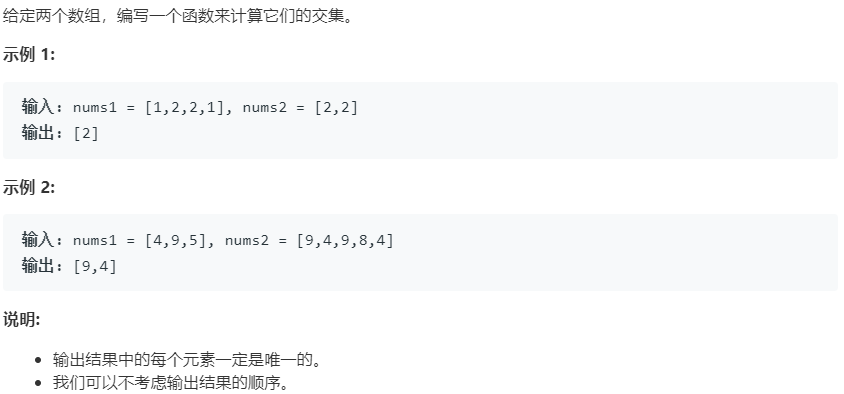
Solution ideas:
Use a hash table query: map array 1, use array elements as subscripts, and hash corresponding elements ++; traverse array 2, also use array elements as subscripts, to determine if the element at that subscript has a value (if it exists in array 1).
Answer (C language):
The operating efficiency is as follows:

Title 6: Calculating prime numbers
The test requirements are as follows:

Solution ideas:
A prime number is a natural number that has no more factors than 1 except 1 and itself.
Eladoser screening:
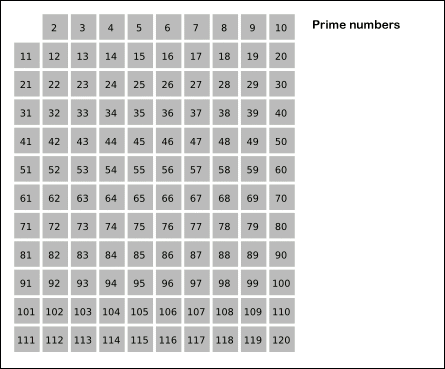
Answer (C language):
int countPrimes(int n) { int *isPrime = (int*)malloc(sizeof(int) * n); memset(isPrime, 0, sizeof(int) * n); int cnt = 0; for(int i = 2; i < n; i++){ if(isPrime[i] == 0){ cnt++; for(int j = i + i; j < n; j += i){ //Sieve out multiples of i isPrime[j] = 1; } } } return cnt; }
The operating efficiency is as follows:

Question 7: Rotating Array
The test requirements are as follows:
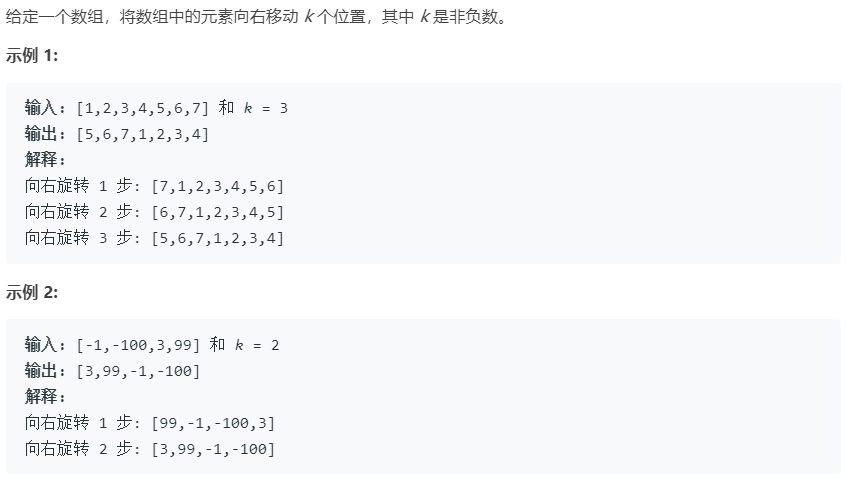
Solution ideas:
Use methods that invert arrays, such as when k is 3:
Original Array: 1 2 3 4 5 6 7
After inverting all numbers: 7 6 5 4 3 2 1
Reverse the first k digits: 5 6 7 4 3 2 1
After inversion of n-k digits: 56 7 1 2 3 4 -->Result
Answer (C language):
static void reverse(int* nums, int numsSize, int start, int end) { int temp = 0; while (start < end) { temp = nums[start]; nums[start] = nums[end]; nums[end] = temp; start++, end--; } } void rotate(int* nums, int numsSize, int k){ k = k % numsSize; reverse(nums, numsSize, 0, numsSize - 1); reverse(nums, numsSize, 0, k - 1); reverse(nums, numsSize, k, numsSize - 1); }
The operating efficiency is as follows:

Question 8: The average number of layers of a binary tree
The test requirements are as follows:
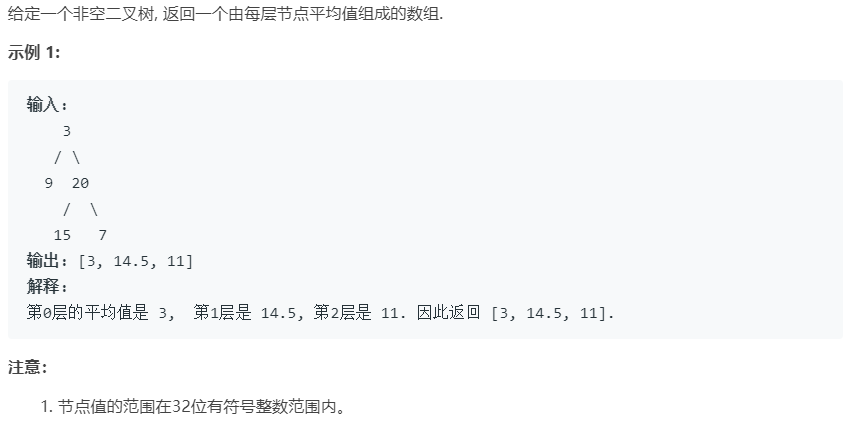
Answer (C language):
/** * Definition for a binary tree node. * struct TreeNode { * int val; * struct TreeNode *left; * struct TreeNode *right; * }; */ /** * Note: The returned array must be malloced, assume caller calls free(). */ void helper(struct TreeNode* root, double* sum, double* count, int index, int* head){ if(root==NULL){ return; } sum[index] += root->val; count[index]++; (*head) = fmax(*head, index); helper(root->left, sum, count, index+1, head); helper(root->right, sum, count, index+1, head); } double* averageOfLevels(struct TreeNode* root, int* returnSize){ int NUM = 10000; double* sum = (double*)calloc(NUM, sizeof(double)); double* count = (double*)calloc(NUM, sizeof(double)); int head = 0; helper(root, sum, count, 0, &head); double* ret = (double*)malloc((head+1)*sizeof(double)); for(int i=0; i<head+1; i++) { ret[i] = sum[i]/count[i]; } *returnSize = head+1; return ret; }
The operating efficiency is as follows:

Topic 9: Building a Binary Search Tree
The test requirements are as follows:
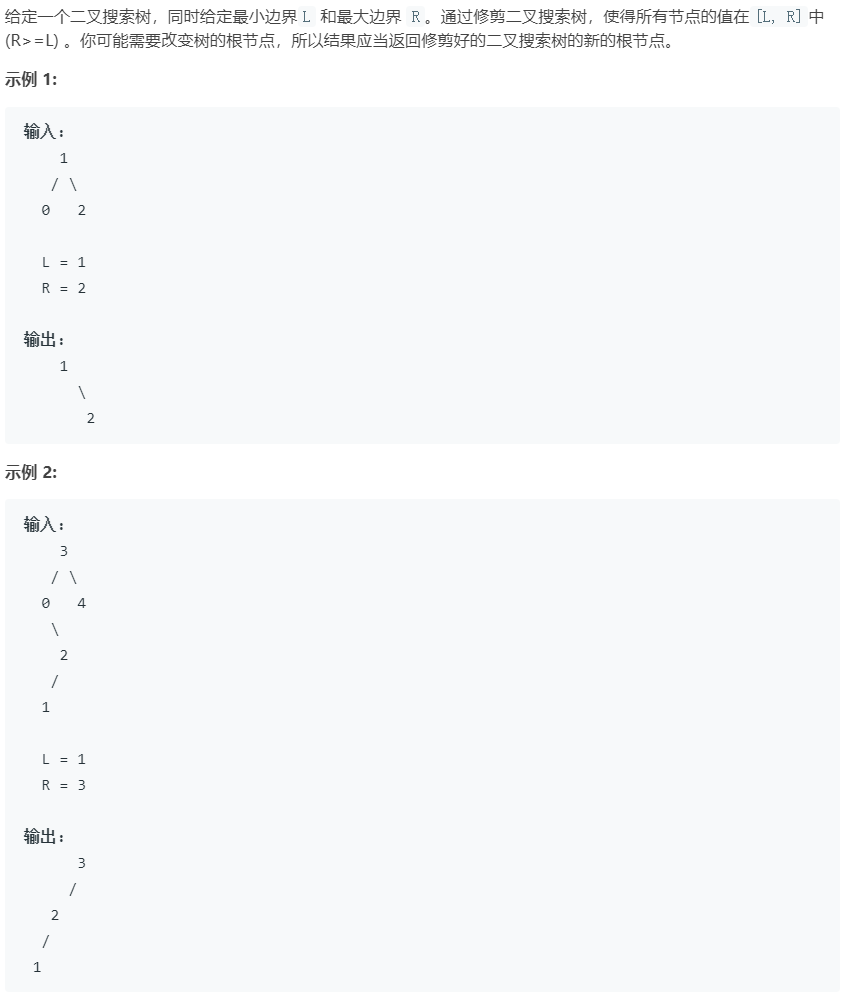
Answer (C language):
/** * Definition for a binary tree node. * struct TreeNode { * int val; * struct TreeNode *left; * struct TreeNode *right; * }; */ struct TreeNode* trimBST(struct TreeNode* root, int L, int R){ if (NULL == root) { return NULL; } if (root->val < L) { return trimBST(root->right, L, R); } if (R < root->val) { return trimBST(root->left, L, R); } root->left = trimBST(root->left, L, R); root->right = trimBST(root->right, L, R); return root; }
The operating efficiency is as follows:

Question 10: Candy distribution
The test requirements are as follows:
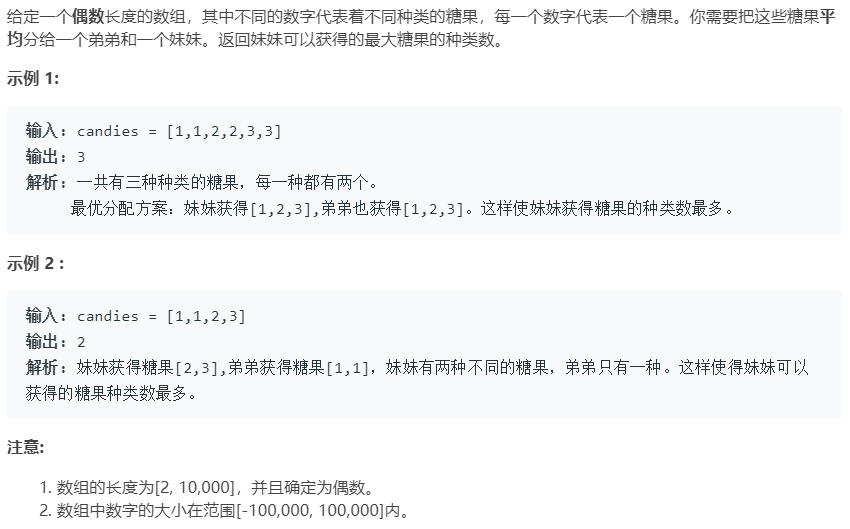
Answer (C language):
int cmpfunc (const void * a, const void * b) { return ( *(int*)a - *(int*)b ); } int distributeCandies(int* candies, int candiesSize){ int cou = 0; qsort(candies, candiesSize, sizeof(int), cmpfunc); for(int i = 0,j = 1;i < candiesSize-1;i++,j = i+1){ if(candies[i] != candies[j]){ cou++; } } cou++; if(cou < candiesSize/2){ return cou; } return candiesSize/2; }
The operating efficiency is as follows:
